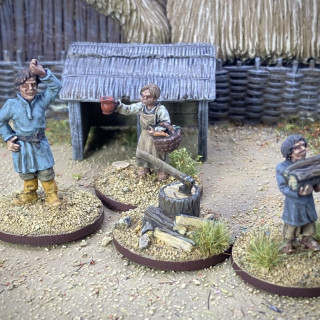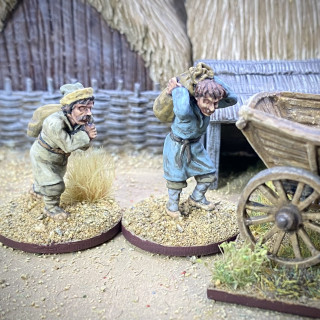
Husaria - Building a Polish army for the 1620s
The Peasants Are Not Revolting
In this project post I add some inhabitants for a typical 17th century Polish village that may appear on my miniature battlefields.
As well as churning through units for the 17th century Polish and Swedish armies that I’m trying to recreate, I am in parallel thinking about the miniature battlefields that they will inhabit. I think that some form of human habitation on the miniature battlefield does a lot to set the context of time and place for the overall scene. As well as any buildings, adding some civilian inhabitants then helps to add further ‘colour’.
There is quite a good selection of 17th century civilians available for Western European theatres. For example Warlord Games do a great selection of 17th century civilians, as well as armed ‘clubmen’. Many other ranges have at least one or two figures available and, with civilian dress giving a bit more historical leeway than uniforms, it is also possible to add in civilian figures from some late 16th century, late 17th century, and even early 18th century ranges, with perhaps just a few tiny conversion. It is even possible to plunder some manufacturers’ ‘fantasy’ ranges; a tip that I picked from the Too Fat Lardies – thanks Rich and Sidney!).
Although parts of Prussian Poland were quite ‘German’ in this period, especially in the larger towns, I wanted some of my civilians to give a more East European feel. We’re not so lucky at the moment when it comes to Eastern Europe civilians in the catalogues of 28mm manufacturers. I was therefore very happy to come across this small set of Eastern European civilians produced by an independent sculptor, Leon, advertised on The Lead Adventure Forum.
The set includes women, men and children going about everyday tasks, a cart with horse and driver, and some pigs with piglets. I thought that these figures would fit in really well to a rural farm or hamlet in the 17th century Polish Lithuanian Commonwealth.
I painted the figures mostly in suitably drab colours to represent typical peasants living in the rural Polish-Lithuanian Commonwealth. The women folk got slightly ‘nicer’ colours, and red head scarves. I based most of the figures on MDF round bases (from Warbases) sized to match the UK 2 pence piece. (Lockdowns etc. have seriously depleted by collection of 2ps!). Warbases do these bases with handy round holes, perfect for tiny magnets, so the resulting figures will sit safely in a Really Useful Box with an A4 magnetic sheet in the bottom.
I kept the basing of the figures mainly muddy earth, with the odd tuft, on the basis that they will usually be shown around the buildings and roads on the miniature battlefield.
This set of figures made an interesting change from the martial units of figures I’m normally working on. I’m sure they will look great as the inhabitants of any hamlets in my miniature 17th century Polish-Lithuanian Commonwealth.
The cart is a metal model which went together fairly easily with superglue. The cart has lots of detail on it so it was very easy to paint with washes and dry brushing.
Next up on the painting table I’m back to more regular fayre with some Polish cavalry.
[Note. At the time of publishing, April 2022, this range of civilian figures may not be available due to them coming from the Russian Federation. ]














































































That one guy…. “I once caught a fish that was THIIIIIS big! “
? sounds about right!